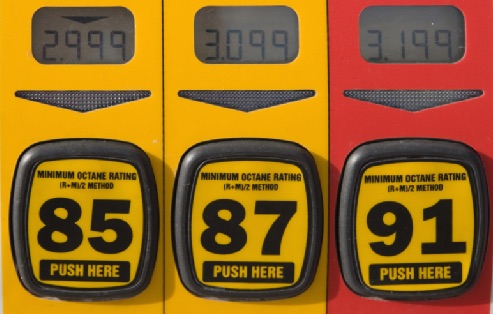Fossil fuels

 C.2 Fossil fuels (3 hours)
C.2 Fossil fuels (3 hours)
Pause for thought
Octane rating
In a gasoline (petrol) internal combustion engine the fuel and air mixture is compressed and then ignited by the spark plug. This ignition occurs at the end of the compression stroke so that the pressure produced by the gaseous products forces the piston to move down. Compression alone can cause hydrocarbons to auto-ignite. If that happens before the piston has reached the end its compression stroke then the resulting explosion can cause a knocking sound. This makes the process much less efficient and can also cause serious damage to the engine. The measure of a fuel’s ability to resist auto-ignition is called its octane rating or octane number. The two reference standards used are 2,2,4-trimethylpentane, which is given an octane rating of 100, and heptane, which is assigned an octane rating of zero. Gasoline (petrol) actually exists normally as a complex mixture of hydrocarbons and contains aromatic compounds such as benzene and methylbenzene (toluene) and cycloalkanes as well as straight chain and branched alkanes. The octane number simply refers to how the fuel’s knocking characteristic compare to the reference value. Thus a fuel with an octane rating of 95 will thus have the same knocking characteristic as a mixture of 95% 2,2,4-trimethypentane and 5% heptane by volume.
Octane ratings provide a nice example of International-Mindedness as different scales are used in different countries to rate the octane number. The most commonly used is RON (Research Octane Number), which is measured under controlled condition at a speed of 600 rpm. Another scale, MON (Motor Octane Number) is measured at a speed of 900 rpm. In North America AKI (Anti-Knock Index) is used. This is sometimes also known as PON (Posted Octane Number) and is often written on the pump as (R+M)/2 as it is the average of the RON and MON values.

The ability of a hydrocarbon to resist auto-ignition under compression decreases with increased chain length (pentane has a value of 62, hexane has a value of 25, heptane by definition is zero, and octane has a value of -20,). The octane number increases with increased branching. This can lead to octane ratings greater than 100. Thus 2,2,3-trimethylbutane has an octane rating of 112 (compare this to its isomer heptane with a value of zero). The process of reforming can also lead to higher octane numbers as this results in either increased branching or the formation of aromatic hydrocarbons such as methylbenzene, which have a higher resistance to auto-ignition.
Nature of Science
Fossil fuels have played a key role in the development of science and technology.
Learning outcomesAfter studying this topic students should be able to: Understand:
Apply their knowledge to:
| Clarification notesThe cost of producing fossil fuels, their availability (reserves) and their impact on the environment should all be considered. International-mindednessAvailability, economic, societal, environmental and technological factors all help to determine which fossil fuels are used by different countries. Different countries use different fuel rating systems (e.g. RON, MON or PON). International cooperation and agreement is required over issues concerning ocean drilling, oil pipelines and oil spills. |
Teaching tipsWhen discussing the origin of fossil fuels explain that they contain sulfur due to the cysteine and methionine residues present in the proteins that formed part of the original biological materials. Sulfur poisons catalysts and hence must be removed before raw petroleum can be properly refined. The reserves of available fossil fuels, although finite, are hard to quantify precisely as new technologies become available to aid in their extraction (e.g. hydraulic fracturing also known as ‘fracking’). Explain the fractional distillation of crude petroleum and the properties and uses of the different fractions. Octane rating is explained in “Pause for thought’ above and this can lead on to one of the main reasons for cracking and reforming. Get students to deduce the equations for these processes so that they can see that alkenes (used for plastics) are also produced during cracking and hydrogen (for use in the Haber process and hydrogenation reactions) in the aromatization process of reforming. The equations for coal liquefaction and gasification also need to be covered. Mention too carbon capture to help prevent the release of carbon dioxide from fossil fuel power stations. Students will need practice at octane rating calculations and also calculating the amount of carbon dioxide produced from combusting different fuels in order to work out carbon footprint contributions. | Study guidePages 142 & 143 QuestionsFor ten 'quiz' questions (for quick testing of knowledge and understanding with the answers explained) see MC test: Fossil fuels. For short-answer questions see Fossil fuels questions together with the worked answers on a separate page Fossil fuels answers. Vocabulary list:cracking Practical work |
Teaching slides
Teachers may wish to share these slides with students for learning or for reviewing key concepts.
Other resources
1. A Guardian video giving three good reasons as to why we need to keep fossil fuels in the ground.
![]() Why we need to keep fossil fuels in the ground
Why we need to keep fossil fuels in the ground
2. A very simple account of the fractions obtained from crude oil and their uses.
![]() Crude oil fractions and their uses
Crude oil fractions and their uses
3. Information on how the cracking and reforming of alkanes can be achieved.
![]() Distillation, cracking and reforming of hydrocarbons
Distillation, cracking and reforming of hydrocarbons
4. The Green Ninja advises on how to reduce your carbon footprint.
![]() Green Ninja: Footprint renovation
Green Ninja: Footprint renovation

 IB Docs (2) Team
IB Docs (2) Team 





















